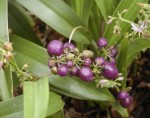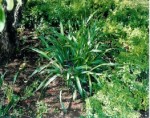Scientific Name: Dianella sandwicense
Indigenous: All HI except Niihau and Kahoolawe
Description: From what I have seen there are two basic forms of ‘uki’uki found through out the state. One form has a more compact growth habit, only about 1-1.5 ft. tall (from now on this one will be referred to as the ‘short’ one) while the other has a taller, less compact look to it and can grow to about 2.5-3 ft. tall (we’ll call this one the ‘taller’ one). Both are beautiful lilies but in their own way. The short one (as seen in the picture above) has dark green leaf blades and when in bloom it sends up a short stalk in the middle of the foliage that is covered with small purple and yellow flowers that once pollinated develop into dark purple or even lavender berries about ½”-1” in diameter. The seeds of this form are black, smooth and extremely glossy. The taller one has lighter green foliage and sends out a taller stalk with much more of the same small flowers but these are usually white and yellow and once they are pollinated the fruit that develop are more transparent looking and not as vibrant purple color, sometimes they look brown and the seeds are not glossy and smooth like the short one, instead they are rough and come in a variety of shapes.
Distribution: All forms of ‘uki’uki are classified as indigenous meaning that they are native to Hawai’i but also other parts of the world. These plants are found in many different vegetation zones from lowland dry forests to higher wet forests, in fact, I’ve seen it growing near the ocean around naupaka as well as in the marsh on the top of Mount Ka’ala and practically everywhere else in between. ‘Uki’uki is found on all the main islands except Ni’ihau and Kaho’olawe, although they most likely occurred there in the past.
Cultural Uses: The leaves can be used for thatching while the berries of the short one make a nice bluish-purple dye for kapa while the taller one usually makes a yellowish-brown dye. As delicious as the berries look, don’t eat them they don’t taste ono at all and they turn your whole mouth blue, trust me I know.
Landscape Uses and Care: This is one of the most durable plants you can have. It does well in practically any growing condition from full sun to practically full shade, outdoors to indoors, moderate water to little water, just about anything. I prefer to use it as an accent plant around large boulders or at the base of larger plants and shrubs. You can even plant it as a mass ground cover but because it grows as a clump and not a runner you will need more of it to cover an area. The only pests to watch out for are white scales and mealy bugs. If you do notice them on the underside of the leaves, they can be manually removed by either shooting them off with water or by cleaning them off with your fingers using soapy water. The plant can also be treated with any store bought pesticide but most likely it is probably ants that are bringing the scales and the mealy bugs to the plants so make sure you treat the ant problem as well. It’s flexibility to handle many types of environments makes this plant ideal for any landscape and in the future I see its popularity increasing tremendously.
Ukiuki









